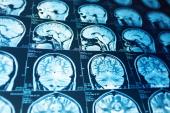ARCADIA: Apixaban No Help for ESUS Patients With Atrial Cardiopathy
The idea that atrial cardiopathy may identify a group that would benefit from anticoagulation isn’t dead, one expert says.

MUNICH, Germany—Among patients with an embolic stroke of undetermined source (ESUS) and signs of atrial cardiopathy, a direct oral anticoagulant (DOAC) is no better than aspirin for preventing recurrent strokes, according to the results of the ARCADIA trial.
The rate of recurrent stroke during follow-up was 4.4% both in patients treated with apixaban (Eliquis; Bristol Myers Squibb) and in those treated with aspirin (HR 1.00; 95% CI 0.64-1.55), and that lack of difference was consistent across stroke types, Hooman Kamel, MD (Weill Cornell Medicine, New York, NY), reported here at the European Stroke Organisation Conference (ESOC).
Prior trials, including NAVIGATE ESUS and RE-SPECT ESUS, also have failed to show that DOAC therapy prevents stroke recurrences after ESUS, but it was hypothesized that certain high-risk subgroups—such as patients with atrial cardiopathy, which has been tied to a greater risk of stroke—may ultimately benefit. The ARCADIA results dampen those expectations.
“There has not been a strategy of anticoagulation where it’s been superior to antiplatelet therapy for secondary prevention after ESUS,” Kamel said.
Commenting for TCTMD, Jelle Demeestere, MD, PhD (University Hospitals Leuven, Belgium), said he had hoped atrial cardiopathy would be the “missing link” that would finally allow for the benefit of anticoagulation in ESUS to emerge.
“I think many people were convinced that patients with certain signs of atrial cardiopathy were probably a subgroup that had a high chance of benefitting from anticoagulation, and so it’s a bit disappointing that this study was not able to show that,” said Demeestere, a member of the ESO public relations committee.
The ARCADIA Trial
Researchers have proposed that ESUS may encompass multiple underlying etiologies that might require different types of antithrombotic therapy for the prevention of recurrent strokes, Kamel said. One etiology could be atrial cardiopathy in the absence of atrial fibrillation (AF). Since oral anticoagulation has been proven to prevent strokes in the setting of AF, it was plausible that such treatment would be beneficial in patients with atrial cardiopathy as well, he explained, noting that a secondary analysis of the WARSS trial, with warfarin versus aspirin, provided some support for the idea.
That provided the rationale to design ARCADIA, conducted across 185 sites participating in the Canadian Stroke Consortium and StrokeNet in the United States. The trial enrolled patients diagnosed with ESUS in the past 6 months who had evidence of atrial cardiopathy defined by one of three biomarkers, including an ECG marker reflective of left atrial abnormalities, an enlarged left atrium on echocardiography, or a serum NT-proBNP level above 250 pg/mL. They were randomized to apixaban 5 mg (or 2.5 mg, if indicated) twice daily plus placebo or aspirin 81 mg daily plus placebo.
Patients with a major cardioembolic source of stroke, including any AF, were not eligible, and if patients were diagnosed with the arrhythmia after randomization, they were started on open-label anticoagulant therapy at the discretion of their treating physicians.
Many people were convinced that patients with certain signs of atrial cardiopathy . . . had a high chance of benefitting from anticoagulation, and so it’s a bit disappointing that this study was not able to show that. Jelle Demeestere
The planned sample size was 1,100 patients, but an interim analysis led the data and safety monitoring board to recommend stopping the trial; there were no safety concerns. At the time, 1,015 patients (mean age 68 years; 54% women) had been randomized, with a mean follow-up of 1.8 years. The median time between ESUS and randomization was about 2 months.
For most patients, the qualifying biomarker of atrial cardiopathy was NT-proBNP (in 58.8%), with 54.4% qualifying based on ECG and 1.8% based on echo. The median NIHSS score was 1, representing a mild stroke population similar to that seen in prior ESUS trials, Kamel said.
The primary outcome was recurrent stroke of any type, and there were no differences between the apixaban and aspirin arms for this endpoint or for subtypes of stroke. Secondary endpoints, including recurrent ischemic stroke/systemic embolism and recurrent stroke/all-cause death, similarly showed no impact of apixaban.
Apixaban was safe, with no cases of symptomatic intracranial hemorrhage observed (compared with 1.1% in the aspirin group. Major hemorrhage other than intracranial hemorrhage occurred in 0.7% of patients treated with the DOAC and 0.8% of those treated with aspirin (HR 1.02; 95% CI 0.29-3.51).
The rate of all-cause mortality was slightly higher in the apixaban group (1.8% vs 1.2%), but the difference wasn’t significant (HR 1.53; 95% CI 0.63-3.74).
Why the Neutral Result?
There could be several reasons behind the lack of benefit observed in ARCADIA, Kamel said.
“It could be that this concept of thrombogenic atrial cardiopathy . . . really isn’t present unless there’s also atrial fibrillation, and there’s questions about how much atrial fibrillation may matter in that context, too,” he said. Or, he suggested, atrial cardiopathy might have to be defined differently to find the group that would benefit from anticoagulation. “There may be better biomarkers of atrial cardiopathy or we may have chosen the wrong thresholds.”
Moreover, patients crossing over to anticoagulation due to AF detected during follow-up or study drug discontinuation could have contributed to the results, Kamel said, adding that his team will be performing secondary analyses to help sort through these and other issues.
For instance, the interplay between AF and atrial cardiopathy warrants further research, he indicated: “There’s a lot that we have to figure out about the link between atrial fibrillation, the burden of A-fib, the underlying atrial cardiopathy or abnormal substrate, and the risk of stroke, and we clearly have a lot more work to do.”
Demeestere agreed that additional studies are warranted, and in particular said that the concept that atrial cardiopathy can be used to identify patients who will benefit from anticoagulation shouldn’t be abandoned.
“I may be biased because I’m quite a believer in the concept, but I think [it should be pursued] because there’s no clear temporal relationship between the timing of atrial fibrillation and stroke,” he said. “So it’s probably not the rhythm disorder itself that causes the thrombus formation. We do know that patients with a higher AF burden have a higher chance of having a thrombus and having a stroke, but there seems to be a missing link. And so the question is if the missing link is atrial cardiopathy, and if so, how do we define this?”
Future studies, then, should aim to better define atrial cardiopathy, and also should try earlier anticoagulation after stroke, he said, noting that patients in ARCADIA were randomized a median of 2 months after their stroke. “That might be a little bit late because we know that most recurrences occur early after stroke,” said Demeestere.
Todd Neale is the Associate News Editor for TCTMD and a Senior Medical Journalist. He got his start in journalism at …
Read Full BioSources
Kamel H. Primary results of the atrial cardiopathy and antithrombotic drugs in prevention after cryptogenic stroke (ARCADIA) randomized trial. Presented at: ESOC 2023. May 24, 2023. Munich, Germany.
Disclosures
- ARCADIA was funded by the US National Institutes of Health/National Institute of Neurological Disorders and Stroke. The study drugs were provided in kind by BMS-Pfizer, and ancillary funding for NT-proBNP assays came from Roche.
- Demeestere reports no relevant conflicts of interest.





Comments